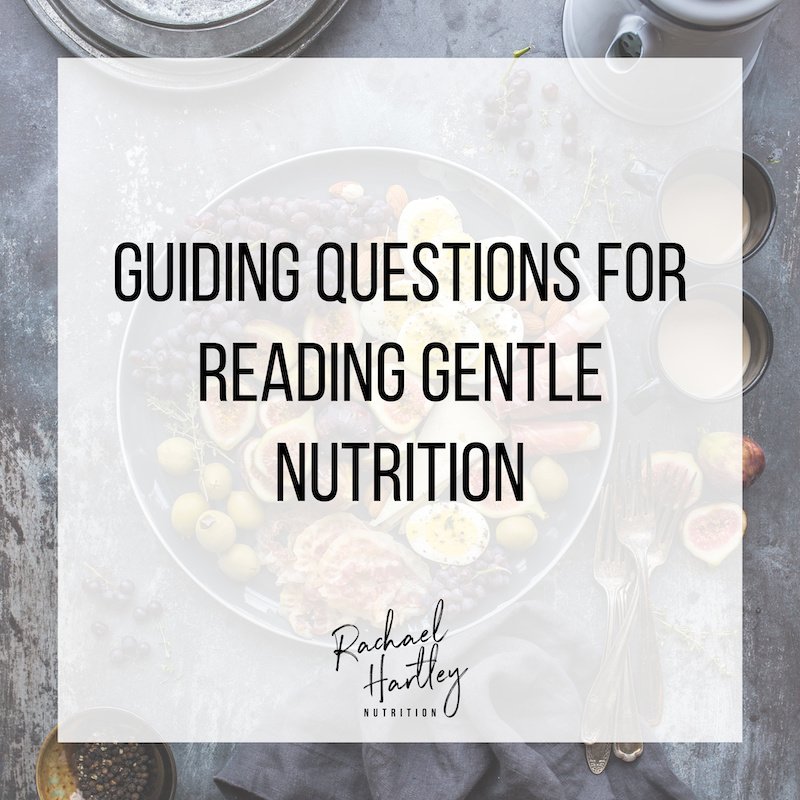Trapped in a pattern of restricting and binging? The dieting pendulum analogy will help you understand the restrict-binge cycle, and give you tools for how to break free.
Read MoreLet’s face it - our cultural relationship with exercise is pretty messed up. With no pain, no gain as a mantra, we often overlook more pleasurable types of movement, or shorter exercise sessions we don’t think will count. This post teaches one of our favorite tools for building a more intuitive relationship with movement - how to build a movement menu!
Read MoreBuilding a mindfulness practice is incredibly helpful in healing your relationship with food, but mindfulness meditation can be intimidating, especially for beginners. Before jumping in, read this post to learn how to start a mindfulness meditation practice.
Read MoreWith the popularity of macro counting, people are more aware than ever of what macronutrients are, yet there is still a lot of misunderstanding about carbs, fat and protein that can make eating stressful. This post answers the question “what are macronutrients” and will hopefully help you feel less stressed knowing how to feed yourself!
Read MoreIf this is your first New Year not setting a weight loss resolution, you might be experiencing some mixed feelings about it. While there can be a sense of loss in stepping away from diet culture, it’s helpful to think about what you are making room for.
Read MoreWith an emphasis on fresh, minimally processed foods, clean eating might be an approach to eating that seems to make logical sense. But when you dig beneath the surface, there’s a lot of problems with clean eating that might not be evident upon first glance. This post discusses how clean eating can go wrong, and what to focus on instead.
Read MorePlanning to read Gentle Nutrition as part of a book club? This blog post contains guiding questions for discussion, so you can make the most out of your read.
Read MoreWith intuitive eating growing in popularity and becoming, dare I say it, trendy, so has the number of providers co-opting intuitive eating to promote dieting. This post is for dietitians to learn more about why intuitive eating should NOT be used in weight loss counseling, and how doing so causes harm to the people intuitive eating was designed to help.
Read MoreIntuitive eating isn’t impulsive eating. This blog post explores how you can listen to your body and brain knowledge together in intuitive eating to make intentional choices with food that help you feel good physically and mentally.
Read MoreIf you started exercising to lose weight, you may have learned to disconnect from your body to cope with harsh and punishing levels of physically activity. Mindful movement, which brings the art of mindfulness to your workout, can help you find joy in moving your body and do it in a safer and more intuitive way. This post includes one of my favorite exercises for bringing mindfulness to physical activity.
Read MoreIntuitive eating teaches you how to eat when you’re hungry and stop when satisfied, but it’s much more nuanced than that! Learn why it’s OK to eat when you’re not hungry in this post on the role of practical hunger in intuitive eating.
Read MoreNeed a new idea for making peace with your fear foods? Get in the kitchen and let your creativity shine! This post explores ways of making peace with fear foods through cooking.
Read MoreOne of the biggest misconceptions about mindful eating is that it’s something that is time consuming, a practice that you have to spend a lot of time on in order to eat every bite of food distraction free. In my practice, I talk to clients about what I like to call real life mindful eating. In this post, I share one of my favorite mindful eating tools using Endangered Species Chocolate NEW Oat Milk Dark Chocolate Bars.
Read MoreIt seems like 347 years ago in October 2019 when I signed my book deal, and I am SO thrilled to share that after over a year of researching, writing, editing, and marketing, Gentle Nutrition is FINALLY here! Learn how you can purchase and support the release!
Read MoreA common question I get from new intuitive eaters is whether you can practice intuitive eating if you have a food related medical condition. You’ll be happy to learn that the answer is yes! Read on to learn how gentle nutrition and intuitive eating fits with medical nutrition therapy.
Read MoreOne way intuitive eating works is by building trust that adequate and pleasurable food is always coming. One way to do that is by stocking your kitchen with the ingredients to easily prepare satisfying meals. Read this post to learn how to stock your kitchen for intuitive eating.
Read MoreEver wonder why 2000 calories is on the back of food labels? It’s not because it’s how much you are supposed to eat. If you want to know where the 2000 calories on food labels comes from - it’s fatphobia. Read this post to understand why 2000 calories is very likely not nearly enough for you.
Read MoreIntuitive eating is a profound act of self care, but when it comes to incorporating gentle nutrition and other self care in a more intentional way, sometimes people can feel stuck in how to do that without turning it into a diet. In this post, learn a simple tool for how to create healthier habits - the intuitive eating way!
Read More


















